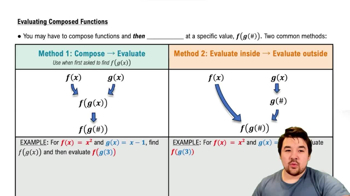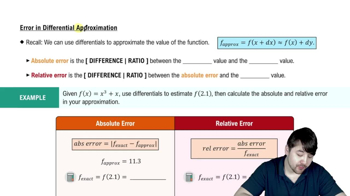Table of contents
- 0. Functions7h 52m
- Introduction to Functions16m
- Piecewise Functions10m
- Properties of Functions9m
- Common Functions1h 8m
- Transformations5m
- Combining Functions27m
- Exponent rules32m
- Exponential Functions28m
- Logarithmic Functions24m
- Properties of Logarithms34m
- Exponential & Logarithmic Equations35m
- Introduction to Trigonometric Functions38m
- Graphs of Trigonometric Functions44m
- Trigonometric Identities47m
- Inverse Trigonometric Functions48m
- 1. Limits and Continuity2h 2m
- 2. Intro to Derivatives1h 33m
- 3. Techniques of Differentiation3h 18m
- 4. Applications of Derivatives2h 38m
- 5. Graphical Applications of Derivatives6h 2m
- 6. Derivatives of Inverse, Exponential, & Logarithmic Functions2h 37m
- 7. Antiderivatives & Indefinite Integrals1h 26m
- 8. Definite Integrals4h 44m
- 9. Graphical Applications of Integrals2h 27m
- 10. Physics Applications of Integrals 2h 22m
4. Applications of Derivatives
Differentials
Problem 4.26.1
Textbook Question
{Use of Tech} Finding all roots Use Newton’s method to find all the roots of the following functions. Use preliminary analysis and graphing to determine good initial approximations.
f(x) = x²(x - 100) + 1
 Verified step by step guidance
Verified step by step guidance1
Start by analyzing the function f(x) = x²(x - 100) + 1. Notice that it is a cubic polynomial, which means it can have up to three real roots. The term x²(x - 100) suggests that the roots might be around x = 0 and x = 100.
Graph the function f(x) to visually inspect where the roots might be located. Look for points where the graph crosses the x-axis, as these indicate potential roots. This will help you choose good initial approximations for Newton's method.
Choose initial approximations based on the graph. For example, if the graph suggests roots near x = 0 and x = 100, you might start with x₀ = 0 and x₀ = 100. If the graph shows another crossing point, choose an initial approximation near that point as well.
Apply Newton's method, which uses the formula xₙ₊₁ = xₙ - f(xₙ) / f'(xₙ). First, find the derivative f'(x) of the function f(x). For f(x) = x²(x - 100) + 1, use the product rule and power rule to differentiate.
Iterate using Newton's method: Calculate x₁ using your initial approximation x₀, then use x₁ to find x₂, and so on, until the values converge to a stable root. Repeat this process for each initial approximation to find all roots.
 Verified video answer for a similar problem:
Verified video answer for a similar problem:This video solution was recommended by our tutors as helpful for the problem above
Video duration:
5mPlay a video:
Was this helpful?
Key Concepts
Here are the essential concepts you must grasp in order to answer the question correctly.
Newton's Method
Newton's Method is an iterative numerical technique used to find approximate roots of a real-valued function. It starts with an initial guess and refines it using the formula x_{n+1} = x_n - f(x_n)/f'(x_n), where f' is the derivative of f. This method converges quickly if the initial guess is close to the actual root, making it effective for functions that are differentiable.
Recommended video:

Evaluating Composed Functions
Preliminary Analysis
Preliminary analysis involves examining the function's behavior to identify potential roots before applying numerical methods. This includes evaluating the function at various points, checking for sign changes, and analyzing critical points and asymptotes. This step helps in selecting good initial approximations for Newton's Method, increasing the likelihood of convergence.
Recommended video:

Derivatives Applied To Velocity
Graphing Functions
Graphing functions provides a visual representation of their behavior, helping to identify roots, intercepts, and overall trends. By plotting the function, one can observe where it crosses the x-axis, indicating potential roots. This visual approach complements analytical methods and aids in selecting effective starting points for iterative methods like Newton's.
Recommended video:

Graph of Sine and Cosine Function







